German Potato Pancakes, or Kartoffelpuffer, are a traditional dish that delivers both comfort and crispiness in every bite. Known for their golden crust and tender, flavorful interior, these potato pancakes are a staple in German households and street markets, particularly during the colder months and festive seasons.
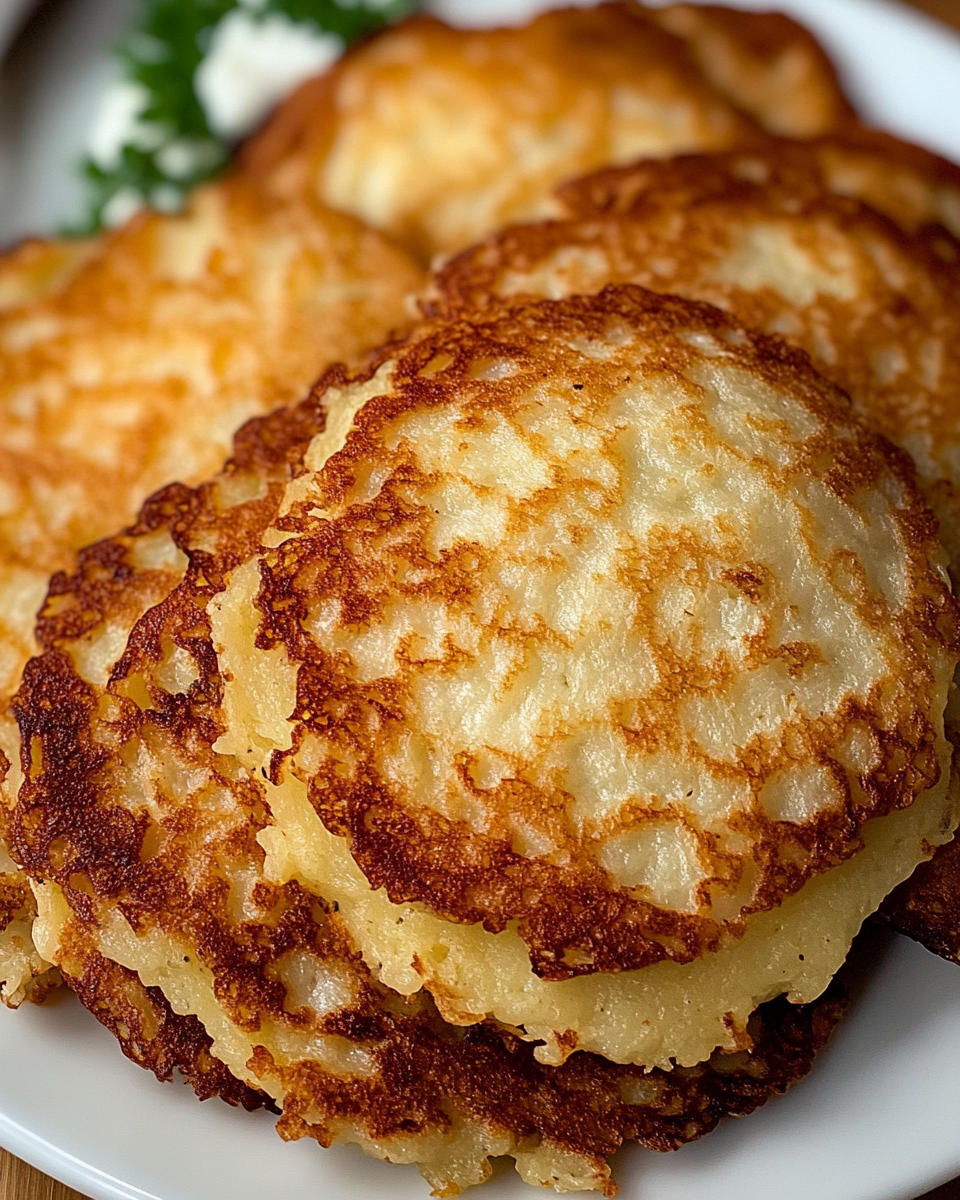
Made from simple ingredients—grated potatoes, onion, flour, and egg—Kartoffelpuffer are easy to prepare and incredibly versatile. They can be served sweet with applesauce or savory with sour cream, making them a favorite across age groups and meal types.
Why You’ll Love This Recipe
This recipe for German Potato Pancakes is the perfect mix of texture and taste. Whether you’re new to German cooking or looking for a nostalgic dish, here’s why this recipe is worth making:
- Crispy on the outside, soft and hearty on the inside
- Made with affordable, pantry-staple ingredients
- Ideal for breakfast, brunch, appetizers, or side dishes
- Easily adaptable with sweet or savory toppings
- Quick to prepare and perfect for meal prepping or parties
Uses and Unique Features
The appeal of Kartoffelpuffer lies in its simplicity and adaptability. In Germany, they are often enjoyed during Christmas markets, street festivals, or cozy family dinners. Beyond their cultural roots, their crispy texture makes them ideal for pairing with various sides and sauces. You can enjoy them as:
- A savory appetizer or party snack
- A side dish to meats like bratwurst
- A vegetarian main with dips or salads
- A sweet treat with cinnamon and applesauce
Preparation Phase and Tools to Use
Making German Potato Pancakes requires minimal tools and prep, but attention to technique makes all the difference in achieving that signature crispiness.
Essential Tools and Equipment
To make this recipe with ease, you’ll need the following:
- Box grater or food processor – For evenly grated potatoes and onions
- Large mixing bowl – To combine and season the batter
- Clean kitchen towel or cheesecloth – To wring out excess moisture
- Large skillet or frying pan – For even frying
- Spatula – To flatten and flip the pancakes
- Paper towels – To drain excess oil after frying
Importance of Each Tool
Each tool plays a crucial role in the success of this recipe:
- Grater or food processor ensures the potatoes are finely shredded for even cooking
- Cheesecloth or towel removes excess water, which prevents sogginess
- Heavy-bottom skillet distributes heat evenly for golden, crisp edges
- Spatula helps in flattening and achieving uniform thickness for perfect frying
Preparation Tips
Before you begin, keep these tips in mind:
- Choose starchy potatoes like russets. They crisp up better and hold together well.
- Drain the grated potatoes thoroughly. Excess moisture leads to soft, oily pancakes.
- Season lightly but evenly, especially if making a savory version.
- Cook immediately after mixing to avoid discoloration of the batter.
Ingredients
Here’s what you’ll need:
- 1 lb russet potatoes, peeled
- 1 small yellow onion
- Pinch of salt, plus more to taste
- Pinch of black pepper (optional, for savory variation)
- 3 tablespoons all-purpose flour
- 1 large egg
- Vegetable oil for frying
Step-by-Step Directions
- Grate the potatoes and onion using the large holes of a box grater. Transfer to a bowl.
- Drain excess liquid by pressing the grated mixture in a cheesecloth or towel.
- Add a pinch of salt, optional pepper, the flour, and the egg. Mix until you get a thick batter.
- Heat 1–2 tablespoons of vegetable oil in a skillet over medium heat.
- Scoop about 2 tablespoons of batter per pancake into the pan. Flatten slightly.
- Fry for 3–4 minutes per side until deeply golden and crisp.
- Transfer cooked pancakes to a paper towel-lined plate.
- Optionally, refry briefly (30–60 seconds per side) for extra crunch.
- Serve immediately with applesauce, sour cream, or your favorite dip.
Variations and Serving Ideas
- Add fresh herbs like chives or parsley for extra flavor
- Try sweet potato for a twist on tradition
- Serve with mustard or horseradish sauce for a spicy kick
German Potato Pancakes (Kartoffelpuffer) are a dish that combines rustic simplicity with rich culinary tradition. Whether served sweet or savory, they’re guaranteed to be a hit.
How to Serve German Potato Pancakes (Kartoffelpuffer)
Kartoffelpuffer are delicious straight from the skillet, but pairing them thoughtfully enhances their flavor and turns them into a complete meal or standout appetizer. Traditionally served with applesauce, they can be customized in both sweet and savory directions, depending on personal preference or the occasion.
Classic Serving Ideas
- With Applesauce: This sweet-savory combination is iconic. The crispy, salty pancake contrasts beautifully with the natural sweetness and tartness of applesauce.
- With Sour Cream or Yogurt Sauce: Add a creamy, tangy component with a dollop of sour cream or a yogurt sauce mixed with chives, dill, or garlic.
- With Smoked Salmon and Dill: Elevate Kartoffelpuffer for brunch or entertaining by topping them with smoked salmon, dill, and crème fraîche.
- With Poached or Fried Eggs: Serve the pancakes alongside or beneath eggs for a hearty breakfast or brunch.
- With a Side Salad: A crisp cucumber or green salad with a light vinaigrette balances out the richness of the fried pancakes.
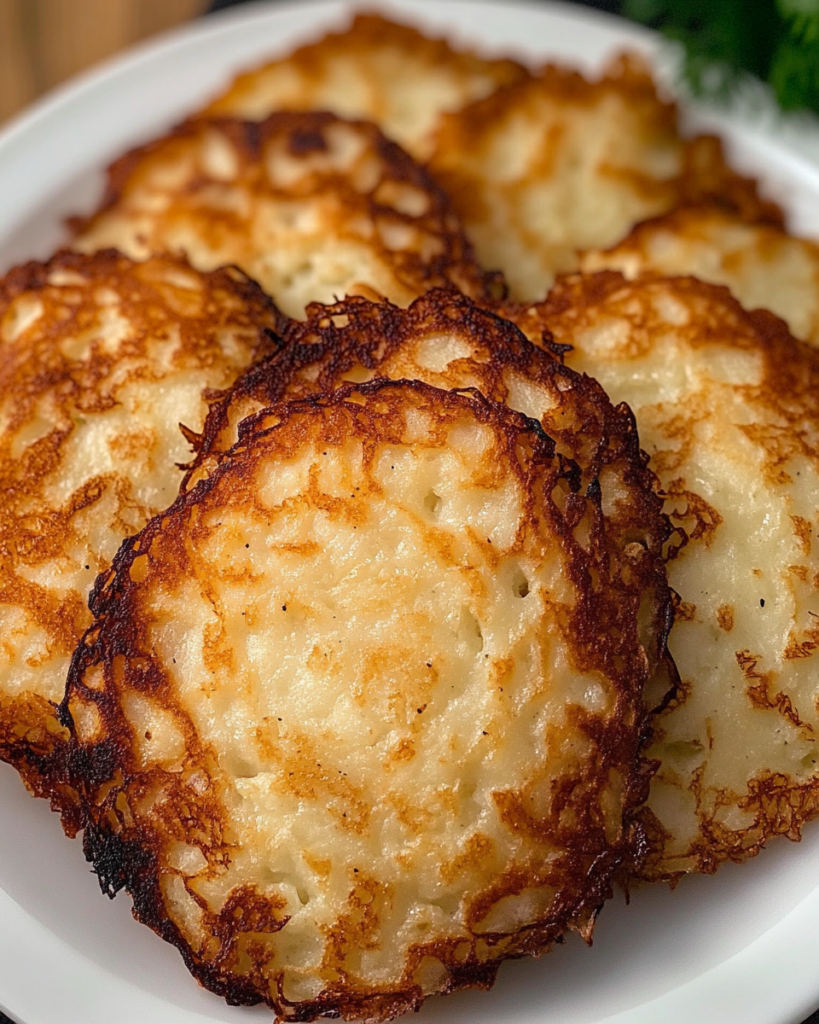
Common Mistakes to Avoid
Perfecting German Potato Pancakes is easy once you avoid a few common pitfalls. These mistakes can lead to soggy, greasy, or bland results. Here’s what to watch out for:
1. Not Draining the Potatoes Enough
Too much water in the batter results in limp pancakes that don’t crisp up. After grating the potatoes and onions, squeeze them thoroughly using a clean kitchen towel or cheesecloth.
Pro tip: Let the mixture rest for a minute, then drain again. More liquid often surfaces.
2. Using the Wrong Potatoes
Low-starch potatoes like red or waxy varieties retain more moisture. Always use russet or high-starch potatoes to help the batter hold together and crisp better.
3. Pan Too Cold or Too Hot
A pan that’s not hot enough leads to greasy pancakes, while one that’s too hot can burn the outside before the inside cooks. Medium heat is ideal. Test with a drop of batter—it should sizzle gently on contact.
4. Overcrowding the Pan
Frying too many pancakes at once lowers the oil temperature, making them soggy. Cook in small batches and allow the oil to return to proper temperature between rounds.
5. Undermixing or Overmixing the Batter
Mix just until combined. Overmixing activates gluten in the flour and can create tough pancakes.
Side Dish Recommendations
Serve Kartoffelpuffer with complementary sides to round out the meal. Whether you’re building a brunch platter or a German-themed dinner, these eight options work beautifully.
1. Applesauce
A traditional and beloved pairing, applesauce adds contrast and nostalgia. Use homemade or high-quality store-bought versions for the best flavor.
2. Sour Cream with Chives
This creamy and tangy option adds a cooling contrast to the crispy, savory pancakes. Add herbs like chives or dill for an extra layer of flavor.
3. German Cucumber Salad (Gurkensalat)
Thinly sliced cucumbers in a vinegar or sour cream dressing provide a refreshing crunch. The acidity cuts through the fried pancake’s richness.
4. Bratwurst or Other Sausages
Serve as part of a hearty dinner plate. The savory, smoky flavor of bratwurst complements the crispy texture of the pancakes.
5. Red Cabbage (Rotkohl)
This sweet and tangy German side dish adds color, texture, and depth of flavor. It works especially well if you’re serving Kartoffelpuffer as a side to meat dishes.
6. Poached or Fried Eggs
Ideal for a brunch option. The runny yolk acts as a rich sauce for the pancakes.
7. Soft Pretzels and Mustard
For an Oktoberfest-style spread, serve with soft pretzels and sharp mustard. The tangy dip enhances the savory nature of the pancakes.
8. Mixed Green Salad
If you’re keeping things light, a simple mixed green salad with lemon vinaigrette brings freshness and balance.
How to Perfect Your Potato Pancakes
To consistently achieve golden, crispy results, keep these additional tips in mind:
Taste and adjust the seasoning after your first batch. You might need a bit more salt depending on your potatoes and toppings.
Double-fry for extra crunch: Fry once, let cool slightly, and refry for 30–60 seconds on each side before serving.
Preheat your skillet fully before adding the batter. Don’t rush this step.
Use a thin spatula to flip gently and avoid breaking the pancake.

Expert Tips for Perfect German Potato Pancakes
To make the most out of your German Potato Pancakes, consider these tested tips that can enhance both flavor and texture:
- Use the potato starch: After draining the grated potatoes, let the liquid settle. The white starch that collects at the bottom can be added back into the batter to improve binding.
- Grate potatoes by hand: A box grater offers more control over the texture. Avoid overly fine or mushy grating.
- Let the batter rest: Allow the batter to sit for five minutes. This helps the flour hydrate and improves pancake cohesion during frying.
- Do not overcrowd the skillet: Leave space between each pancake for even browning and better texture.
- Choose neutral oils with high smoke points: Vegetable or sunflower oil works best. Avoid olive oil, which may burn too quickly.
These small adjustments can turn a good pancake into a great one.
Storage Instructions
If you’re making German Potato Pancakes ahead or have leftovers, proper storage is essential to maintain their crispiness and flavor.
- Refrigeration: Store cooled pancakes in an airtight container with parchment paper between each to prevent sticking. They will keep for up to 3 days in the refrigerator.
- Freezing: Lay pancakes flat on a baking sheet to freeze individually. Once frozen, transfer them to a zip-top freezer bag. Use within 2 months for best quality.
- Avoid stacking warm pancakes: This traps steam and leads to sogginess. Let them cool fully before storing.
How to Reheat Potato Pancakes
Reheating correctly is key to reviving their crisp texture. Avoid microwaving, which softens the exterior.
- Skillet Method: Heat a small amount of oil in a nonstick pan over medium heat. Fry each side for 1–2 minutes until crisp and warmed through.
- Oven Method: Preheat oven to 375°F. Place pancakes on a wire rack set over a baking sheet. Bake for 8–10 minutes.
- Air Fryer Method: Heat at 350°F for 5–6 minutes. Flip halfway for even crisping.
These methods will help bring back the original texture and flavor.
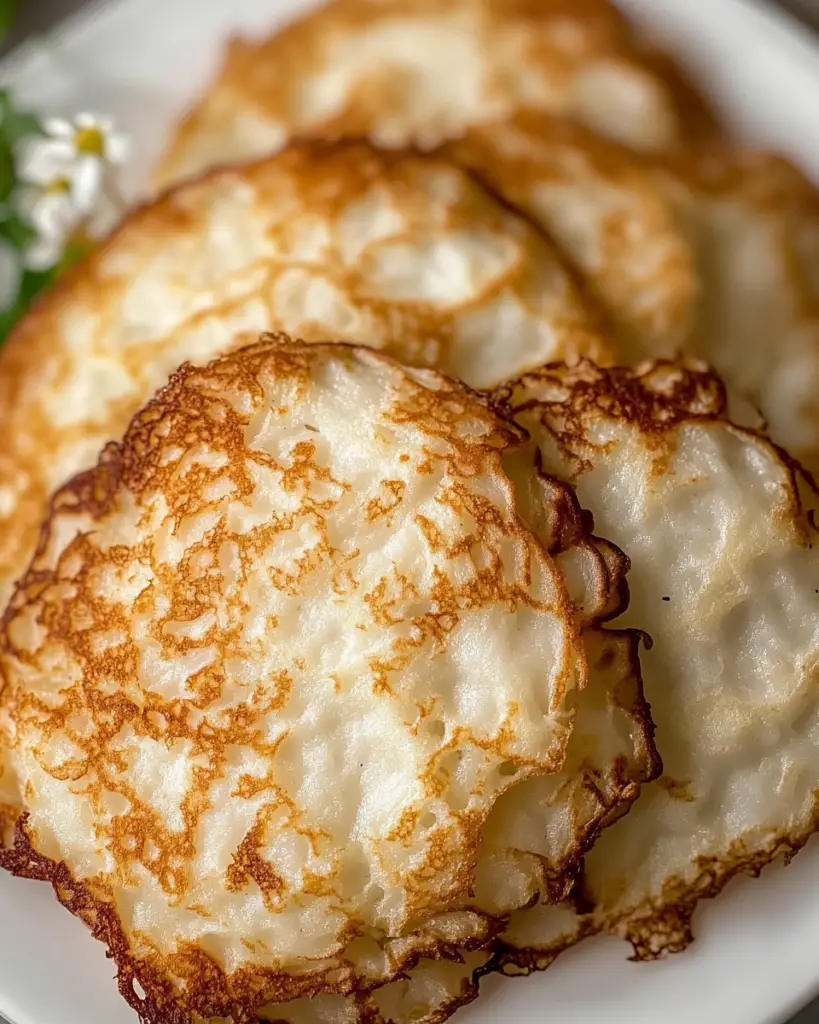
Frequently Asked Questions (FAQs)
What are German Potato Pancakes called?
They are traditionally called Kartoffelpuffer in Germany. In some regions, they may also be referred to as Reibekuchen.
Are these the same as latkes?
While they are similar in ingredients and preparation, latkes are a Jewish dish typically made with matzo meal and sometimes include baking powder. German Potato Pancakes are usually simpler and more rustic in texture.
Can I make these ahead of time?
Yes. You can prepare and refrigerate the batter for a few hours or fry the pancakes ahead and reheat them just before serving.
Can I freeze potato pancakes?
Absolutely. Once fully cooled, freeze them individually and store in a sealed bag. Reheat in the oven or skillet for best results.
Are these gluten-free or vegan?
The traditional recipe includes flour and egg. However, you can make them gluten-free by substituting a gluten-free flour blend. For a vegan version, use a flaxseed egg or potato starch slurry.
How do I get them crispy?
The key is draining the moisture well, using the right oil, and frying at the correct temperature. Re-frying also adds to the crunch.
Why are my pancakes falling apart?
This could be due to excess moisture or not enough binding. Ensure the mixture is well-drained and that the flour and egg are fully incorporated.
What do Germans serve with potato pancakes?
Traditionally, they are served with applesauce or sour cream. At festivals, they may also be paired with sausage or red cabbage.
Conclusion
German Potato Pancakes are a timeless dish that combines comfort, tradition, and versatility. Their crispy edges and tender interiors make them irresistible, whether served with sweet applesauce or a tangy yogurt sauce. They’re easy to prepare, ideal for any occasion, and customizable for various diets and preferences.
This recipe is more than a quick meal—it’s a connection to German culture and home-cooked tradition. With a few simple ingredients and the right technique, you can enjoy authentic Kartoffelpuffer that rival any street vendor or grandmother’s table in Germany.
For more traditional sides to serve with this recipe, explore our guides on German red cabbage, authentic sauerkraut, or homemade applesauce.
German Potato Pancakes (Kartoffelpuffer)
Ingredients
- 1 lb russet potatoes
- 1 small yellow onion
- Pinch of salt plus more for seasoning
- Pinch of black pepper optional, for savory pancakes
- 3 tablespoons all-purpose flour
- 1 large egg
- Vegetable oil for frying
Instructions
- Wash and peel the potatoes. Grate them using the large holes of a box grater into a mixing bowl. Grate the onion into the same bowl.
- If excess liquid pools in the mixture, drain off as much as possible to avoid soggy pancakes.
- Add a pinch of salt, black pepper (if using), flour, and the egg. Mix thoroughly with your hands or a spoon until a thick, cohesive batter forms.
- Heat 1–2 tablespoons of vegetable oil in a large skillet over medium heat.
- Scoop about 2 tablespoons of batter per pancake into the hot oil. Flatten each scoop slightly with the back of a spoon or spatula.
- Fry for 3–4 minutes on each side, or until deeply golden brown and crispy.
- Transfer the cooked pancakes to a paper towel-lined plate to drain excess oil.
- Once all the pancakes are fried, optionally re-fry each one for 30–60 seconds per side for extra crunch.
- Serve immediately while hot and crispy with your choice of applesauce, brown sugar, sour cream, or yogurt sauce.



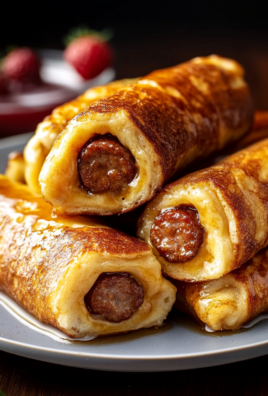
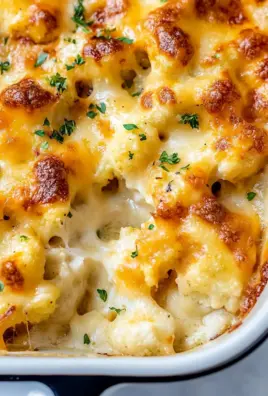

Leave a Comment